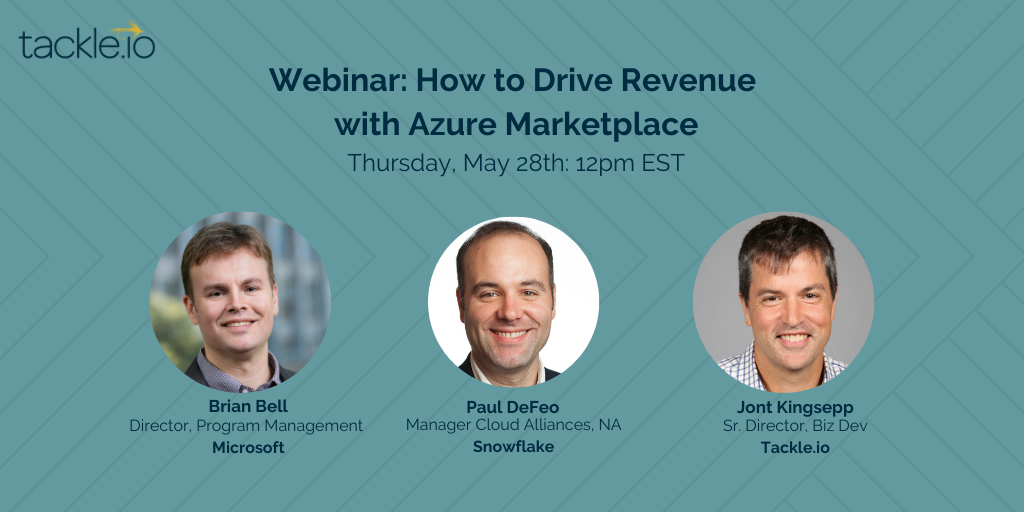
If you’re still thinking Cloud Marketplaces are just a place to list your developer software for single-use purchases, you’re not alone. It’s a relatively new channel, but we’re seeing exponential growth and innovative evolution in this space.
Forrester predicts that 17% of the whopping $13 trillion in B2B spending will flow to Marketplaces by 2023. For reference, that 17% would amount to two trillion dollars.
And it makes sense, right? Marketplaces have the potential to accelerate time to revenue, make procurement easier, and meet your buyers where their wallets already are to simplify purchasing. 73% of B2B buyers already report that buying through channels Marketplaces is very convenient. (If that makes your ears perk up, hang tight! We’re going to touch on all three of these areas.)
For some background, the Microsoft Azure Marketplace alone has millions of customers across 141 regions and 17,000 certified apps and services listed. This new Marketplace-driven sales channel represents plenty of opportunities to discover new audiences and expand current accounts, but a solid marketing strategy is key.
It’s also not easy. Luckily, we can look at how other companies have successfully adopted Cloud Marketplaces to inspire your journey and uncover what it takes to be successful.
In our webinar, How to Drive Revenue with Azure Marketplace, we talked to three experts about using Microsoft’s Azure Marketplace to scale businesses. Brian Bell of Microsoft, Paul DeFeo of Snowflake, and Jont Kingsepp of Tackle shared their insights on topics like:
- Snowflake’s journey onto the Azure Marketplace
- What ISVs should focus on to make the most of Marketplaces as a new sales channel
- The benefits of Marketplaces to software sellers
- Best practices for accelerating the buying process on Marketplaces
Here’s what they shared:
Marketplace offers a faster buying cycle
Snowflake is a cloud data platform that worked with Tackle to get listed with Microsoft’s Azure Marketplace.
As a cloud data platform themselves, selling via Cloud Marketplaces was a natural extension. Not to mention the simplification of the buying process in this channel, and increased control over the buying process for customers.
Snowflake also found that many of their customers already have Microsoft Cloud budget commitments, making purchasing via the Marketplace easier. The ability to take advantage of those contracts and leverage Microsoft Azure enrollment or commitment helps because they can leverage [pre-approved budget] to buy technologies like Snowflake.
Not only that, but their customers also already have some of the integration in place with procurement systems like SAP Ariba or Coupa. That makes it easier for them to justify the initial spend, and even spend a little bit more as a result.
While quick transactions can benefit all buyers, for some industries, Marketplace availability is becoming a have-to-have, rather than a nice-to-have.
Brian Bell, Director of Program Management at Microsoft, noted that “what we’re seeing is a trend in procurement behavior, especially around large enterprises and governments. [These clients] only want to transact in the Marketplace because they already have a commercial relationship with Microsoft. They already have the commitment [and] contracts in place, [and] their procurement department already understands the billing and the payment terms.”
“So we have large enterprises and governments telling their software vendors, “Hey, I only want to buy through the marketplace.” If you’re not in the Marketplace and you’re selling into large enterprises or any government, you may want to make sure you have transactive offers.”
With a strategy, you can discover new audiences via Azure
To an extent, Cloud Marketplaces come with a built-in audience. However, success takes a little more effort than simply showing up.
Brian explained that “one of the things we ask our ISVs to think about is [that] it’s not just an app store. It’s more of a channel. It helps with discoverability, but you can’t just list something and forget it.”
He continued, “You actually have to work the channel. You have to treat it like any other channel that you have existing. I mean, certainly, we have three and a half million monthly active users coming to the Marketplace looking for solutions. So it’s going to help get you some discoverability, but you have to market and promote your solution. You have to sell that sizzle.”
Jont Kingsepp, Sr. Director of Business Development at Tackle.io, echoed the sentiment. He noted that “this is a new channel that really should be treated as such. I think ISVs that are getting the most success from transactions and visibility and inbound leads, et cetera, are the ones like Snowflake that are investing the most in it.”
If you want to drive organic traffic to your listing, conversations have to happen from the top of the company down. Executive buy-in helps get everyone working towards a common goal, which can accelerate growth. While initial Marketplace interest may come from the sales or marketing team, we have a feeling your C-Suite is just as interested in deal velocity and guaranteed collections as you. You’ll also need to invest in tactics like sharing availability with your audience, launching Marketplace-specific landing pages, sharing launch videos, and more.
An empowered sales team can build momentum
Another component of your Marketplace success that you can’t afford to overlook is your existing sales team. Educating sales teams about how to leverage the channel, and then sharing that success with sellers, is essential to building momentum and traffic on the new channel.
Jont said that “at Tackle, we talk to the sales teams for our customers because [you have to invest there]. So we’ve got the effort to get online, and we’ve talked about marketing, but from a sales perspective, you do need to be enabling sales teams to carry a Marketplace conversation.”
For Snowflake, they’ve done this by building out a lot of benefits and listing them to their field sellers so that they are aware they’re published on the Marketplace. That means they can answer those questions directly with their customers and share that it is a viable option for you to purchase Snowflake through the Marketplaces.
Additionally, some of the conversations that Tackle has with sales teams center on which customer segments they should start with.
“Which customers are primed to go through Azure Marketplace? A lot of that depends on the size of the relationship, et cetera. A lot of the customers [are] not aware that this is an option yet. And so it’s up to you to enable your sales team and equip them to carry the conversation with the right customers.” Jont added.
Marketplace pricing terms and billing options are flexible
One misconception about Marketplace mentioned earlier in this post is that it only supports try-and-buy models that give users instant deployment and short-term access purchased by the hour or by usage. Historically, that model worked well for developer software that was the bulk of the Marketplace apps. Today, the audience is much broader and it’s much more flexible.
When you’re deciding how you’d like to begin your Marketplace journey, you’ll have different billing options and pricing terms to choose from. The Marketplace’s adaptability means it can flex to work with however you like to sell, and your buyers like to buy.
Brian shared that “[There are] different kinds of available billing models. So it’s not just deployment, which there are tons of different ways to deploy in the Marketplace. You can deploy as Virtual Machines (VMs) or a cluster of VMs. You can have a SaaS, or you can build your platform as a service and sell it through the Marketplace.”
“But it’s also all the billing options that you have. You don’t have to go back to your engineers and say, “Hey, can you design this whole different business model for us? Can you engineer and create this whole business model?” You can do that inside the Marketplace with our APIs.”
Some Cloud Providers choose to charge by the hour for their software on Marketplaces. Brian added that you could unlock hourly billing to see if it’s a good fit for your company.
“Developers can start using it and see if they like it. Then your enterprise sales force can come in and engage in cross-selling and upselling that new user. So I think that billing model flexibility is key to unlocking new segments of the market.”
When it comes to pricing terms, there are two options to choose from—public offers or Private Plans. Snowflake has experience offering both.
For public offers, that’s typically a packaged offerings with fixed pricing models that anyone can see, purchase, and test and that’s a low friction model.
Private Plans, however, are not made publicly available. Private Plans allow you to do more customization as far as delivering contracts. It may be a bit more challenging, but that flexibility and the control of the customer experience of how they’re buying your product is certainly attractive and is part and parcel to why Snowflake decided to list the service in that manner.
Tackle has processed thousands of transactions, and Jont noted that a majority of current Marketplace sales are Private Plans. “I think with Azure Marketplace, in particular, what we’ve seen is a great improvement in all the investments over the last six months or so, is flexibility around how you convey those Private Plans, mostly the custom terms.”
Marketplaces want to help you sell
Listing your SaaS on a Cloud Marketplace is a team sport, but your company doesn’t have to go at it alone. What you’ll find is that Marketplaces want to help you sell, and as you invest in Azure Marketplace, they’ll invest in you.
As you sell via the Marketplace and deliver value to the Cloud Provider’s buyer, you can take advantage of co-sell opportunities. Partnerships with Marketplaces are one of the reasons sellers choose the channel, and they grow over time.
Brain shared that “you unlock benefits with co-sell such as lower fees, increased visibility throughout the field and through the partner channels, different merchandising in the Marketplace, things like that.”
Marketplace Rewards on Azure Marketplace are yet another way to help you sell. Brian explained that this reward system is Microsoft’s “way of meeting you where you are in your publisher journey.”
At the beginning of your Marketplace journey, they “help you optimize your landing page and your content, and do some social promotion, things like that.”
As your Marketplace sales increase, so too do the benefits. “The more you put into the Marketplace, the more you get out. So we’ve designed a program, so as you scale within the Marketplace, we scale with you and unlock additional benefits.”
Marketplace Rewards program is very advantageous, including things like entering new channels, running social campaigns, and drumming up new business.
Selling your software on Cloud Marketplaces like Azure is a great way to accelerate deals and get in front of new audiences. However, you’ll need to strategize your launch and empower sales teams with information to make it a success.


